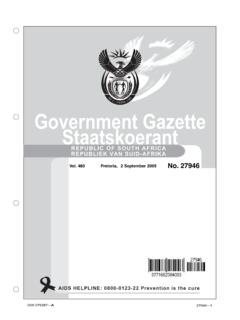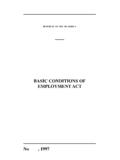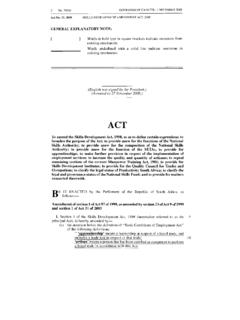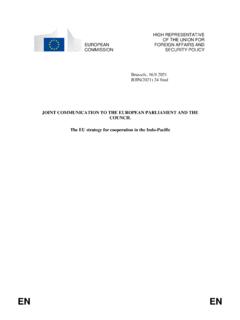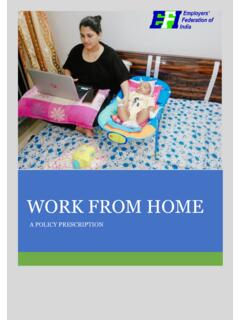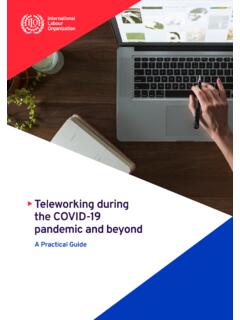Transcription of Health and Safety
1 The Profile of Occupational The Profile of Occupational Health and SafetyHealth and SafetyHealth and SafetySouth AfricaSouth AfricaTHE PROFILE OF OCCUPATIONAL Health AND Safety SOUTH AFRICAThe Profile of Occupational Health and Safety South AfricaA project commissioned jointly by the International Labour Organisation and the Department of Employment and Labour, South AfricaPretoria, 2020 Authors: Sibongiseni S Myeni (DBA, MBA, MMedSc, BSc Hons, BSc), SeniNhle Occupational Health J Ngcobo (MBChB, MScMed, MBA, DOH, DTM&H, DCH), SeniNhle Occupational Health Department of Employment and Labour South Africa and the International Labour Organization. ACKNOWLEDGMENTS The authors express sincere gratitude to the Inspectorate and Enforcement Services Branch of the Department of Employment and Labour and their efficient office.
2 We are indebted to the Chief Inspector, Mr Tibor Szana and Ms Bulelwa Huna, for their insightful comments in reviewing the initial draft of this report, their support with providing key information as well as in facilitating communication with the stakeholders. Our sincere gratitude to Mr Phumi Maphaha, Mr Jacob Malatse and all staff members at the Department of Employment and Labour for their availability and facilitating access to are grateful to the members of the Advisory Council for Occupational Health and Safety for initiating this process and for their guidance and support during the data collection express our gratitude to ILO South Africa Office and ILO Eastern Africa Office and especially the OSH Specialist, Ms Penny Munkawa for her guidance and support in compiling this document as well as inputs in the earlier drafts of the sincerely thank all the stakeholders and everyone who participated in the interviews and made contributions by responding to the questionnaires that were sent to them.
3 We appreciate their time in being part of this process and mindful of the fact that this report would not have been without their highly valued inputs and Health and Safety in the Republic of South Africa is more than a century old with inspectors operating in Health and Safety towards the end of the 19th century. This coincided with the rapid development of the industry after the discovery of diamonds in the 1860 s and the discovery of gold in the 1880 naturally gave rise to the 1st Industrial revolution in South Africa moving from what was largely an agrarian society at the time. At that time, South African was a colony of the United Kingdom. As a result, the systems in Health and Safety that were developed in the UK, were introduced to its colonies.
4 All the required policies were then developed and introduced. Even though the first Health and Safety policy focused on Safety as espoused by the Machinery and Occupational Safety Act no 6 of 1983 (MOS Act), we went on to recognise the importance of Health at the workplace. As the saying goes a Health workplace is a safe workplace whereas, a safe workplace is not necessarily a healthy workplace. It was out of this realisation that the OHS Act was later, I became an inspector. I was able to experience first-hand what it was like working on the ground, having to protect the most vulnerable of workers by ensuring decent work was a reality for them. After doing many, many inspections, I was able to put it into practice all the valuable lessons when I was responsible for developing policy after I became Chief Inspector several years laterWe are now on the cusp of the development of the fifth OHS Act (currently in Bill form) which I believe will revolutionise the current Health and Safety practises and offers greater protection for workers, while equally protecting complying employers.
5 This Bill was the culmination of years of stakeholder and partner interaction at NEDLAC. The Bill has been approved for public comment by the Cabinet of South Africa, through the Department of Employment and Labour (IES: Health and Safety ), has always enjoyed a strong relationship with the ILO. I had the privilege of ensuring that South Africa became a signatory to Labour Inspection Convention, 1947 ( ).This document that you have in your hands is a valuable document in that it is the first of its kind. It is not just about occupational Health and Safety for which the Department of Employment and Labour is responsible, it covers all aspect of occupational Health and Safety in South Africa. This document is a culmination of work done by all government departments and entities, both statutory and non-statutory institutions that are responsible for occupational Health and Safety in South would like to recognize the following key role players in the development of this document: The ILO, for funding the project and playing a significant role in its development.
6 Dr Sibongiseni Myeni: Occupational Hygienist and Leadership Specialist (DBA, MBA, MMedSc, BSc Hons) Dr Ntombenhle Ngcobo : Occupational Medical Practitioner (MBChB, MScMed, MBA, DOH, DTM&H, DCH) In conclusion, I commend the Inspector General, Aggy Moiloa, and her team on the work done in ensuring that this project was driven to a successful Lamati (Mr) Director General: Employment and Labour Republic of South Africa 07 June 2021 PREFACEWe present to you, the National Occupational Health and Safety (OHS) profile. This document has been long in the marking. The realisation that something needs to be done around consolidation of OHS relate processes has long been then. The task was daunting for the longest of time, but when we finally delved into it, we did not hold forthcoming pages are rich with potential.
7 You will notice that quite a bit of space is provided to reflecting on the legal framework of OHS. Both local and international lawful building blocks were considered to a large extent. This includes laws, regulations, directions, conventions, recommendations and observation should be made that at the centre of this national profile of OHS, are the intended beneficiaries. It should not be misconstrued that these are just limited to the human element. It can be argued that a sound national OHS profile would bode well for the Health of the economy as well. This is not meant to underplay the socio-economic impact of this but to simple state that our thinking should be opened to the convolution of economic and human will perceive that this national profile cannot be complete without a reflection on the operational environment, which is effectively made up of systems, processes and people.
8 To give credence to meaningful implementation and application of Safety and Health related standards and practices, it is rather obvious that the operational environment cannot be stakeholders came together to present with an opportunity of rich engagements and consultations. This includes: various government departments, state agencies and entities, research and academic institutions as well as standard setting bodies, Each played an indispensable role towards the putting together of this document is a first of its kind. There s little doubt that this is an exciting opportunity as it offers a leverage for future like Aggy MoiloaInspector General: Inspections and EnforcementDepartment of Employment and LabourSouth AfricaJune 2021 CONTRIBUTORSC ompetent authorities and institutions African Union Development Agency-New Partnership for Africa s Development Department of Employment and Labour Department of Health .
9 Medical Bureau for Occupational Diseases and Compensation Commissioner for Occupational Diseases Department of Mineral Resources and Energy International Labour Organization National Institute for Occupational Health South African Bureau of Standards South African Maritime Safety Authority South African National Accreditation System South African Police Service - ExplosivesProfessional bodies Employee Assistance Professionals Association of South Africa Ergonomics Society of South Africa Health Professions Council of South Africa Institute of Working at Height Mine Medical Professionals Association Southern African Institute for Occupational Hygiene South African Institute of Occupational Health and Safety South African Society of Occupational Health Nursing Practitioner South African Society of Occupational Medicine South African Qualification & Certification Committee Fire South African Qualification & Certification Committee GasTABLE OF CONTENTSEXECUTIVE SUMMARY IX1.
10 INTRODUCTION 12. METHODOLOGY 23. FINDINGS FROM IN-DEPTH INTERVIEWS 24. NATIONAL REGULATORY FRAMEWORK Laws and Regulations The Constitution Laws, Regulations and Collective Bargaining on OSH Laws and Regulations Related to OSH Under Other Ministries ILO Conventions Ratified by South Africa. Legislation on Gender Equality and Non-discrimination Application of International Standards Legislation Cognisance of Biological Differences Legislation on Sectors and Occupations Where Women and Men Work.

